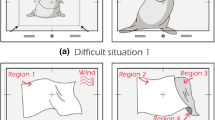Abstract
The automatic in-betweening technology is one of the most important technologies in computer-assisted animation. The preprocessing of inconsistency of the topological structure between the start and the end key frames is time-consuming in the traditional in-betweening algorithm. Therefore, in order to guarantee the consistency of the topology structure between the start and the end key frames, we present in this paper a new mesh-based automatic in-betweening algorithm for the key frame animation. By meshing a three-dimensional object, all the infinite and disorderly points on the surface of an object can be converted into finite and ordinal points according to some principles of each layer and between layers, and then a series of in-betweens can be automatically generated in terms of an interpolation function. The algorithm in this paper presents a solution to the corresponding principles of the vertices on each layer and between layers after meshing the start and the end key frames. The experimental results demonstrate that the animation generated based on this method is smooth, natural, and fluent. In application, our algorithm can improve the efficiency of animation production as well as greatly reducing the cost.
Similar content being viewed by others
References
Kort A. Computer aided in-betweening. In: Proceedings of the 2nd International Symposium on Non-photorealistic Animation and Rendering. Annecy, France, 2002, 125–132
Jin X G, Bao H J, Peng Q S. A survey of computer animation, Journal of Software. 1997,8(4), 241–251 (in Chinese)
Di-Fiore F, Schaeken P, Elens K, et al. Automatic in-betweening in computer assisted animation by exploiting 2.5D modeling techniques. In: Proceeding of Computer Animation. Seoul, 2001, 192–200
Di-Foice F, Van-Reeth F. Employing approximate 3D models to enrich traditional computer assisted animation. In: Proceedings of Computer Animation. Geneva, 2002, 183–192
Lake A, Marshall C, Harris M, et al. Stylized rendering techniques for scalable real-time 3D animation. In: Proceedings of the 1st International Symposium on Non-photorealistic Animation and Rendering. Annecy, 2000, 13–20
Martin D, Fekete J D, Torres J. C., Flattening 3D objects using silhouettes. In: Proceedings of EUROGRAPH 2002. Saarbrucken, 2002, 239–248
Kalnins R D, Davidson P L, Markosian L, et al. Coherent stylized silhouettes. In: Computer Graphics Proceedings, Annual Conference Series, ACM SIGGRAPH. San Diego, 2003, 856–861
Durand F. An invitation to discuss computer depiction. In: Proceedings of the 2nd International Symposium on Non-photorealistic Animation and Rendering. Annecy, 2002, 111–124
Zhou Y X, Shi J Y, Yu J R. Physics-based animation of smoke. Journal of Computer-aided Design & Computer Graphics, 2006, 18(9): 1367–1371 (in Chinese)
Liu L G, Wang G J. Shape blending between 3-D triangular meshes based on their intrinsic variables. Chinese Journal of Computers, 1998, 21(9): 850–854(in Chinese)
Wu W G, Jin X G, Feng J Q, et al. Triangle morphing. Journal of Computer-aided Design & Computer Graphics, 2005, 17(7): 1615–1619 (in Chinese)
Author information
Authors and Affiliations
Corresponding author
Rights and permissions
About this article
Cite this article
Chen, C., Zheng, Y. & Sarem, M. A mesh-based automatic in-betweening algorithm in computer-assisted animation. Front. Comput. Sc. China 1, 241–245 (2007). https://doi.org/10.1007/s11704-007-0025-0
Received:
Accepted:
Issue Date:
DOI: https://doi.org/10.1007/s11704-007-0025-0




